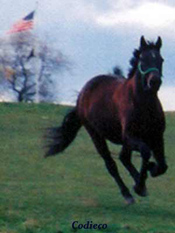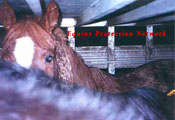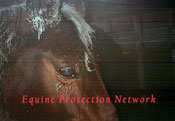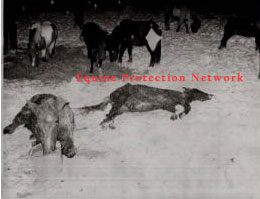
Join the EPN Announcement Only Mailing List
Shop for CD's at CDRush.com & the EPN Benefits!
Put "EPN" in the Coupon Code box when you place your order.
Now you can save money on your favorite music and help the horses at the same time!
EPN Website Sections
Press Stories 1980-2004
The Final Roundup Pittsburgh Magazine 5 /2004
Fighting to Stop the Sale & Slaughter of US Horses in Foreign Countries - KDKA TV Investigates 4/30/2004
The Slaughter Question Horse & Rider 12/2002
State Ranks High in Equine Slaughter WTAE's Paul Van Osdol Reports 4/27/2001
Slaughterhouse Ride WISH TV News 8 I-Team Investigative Report 4/2001
Illinois Defeats Horse Slaughterhouse! 1999
Kill Sale Pittsburgh Post Gazette 6/ 1999
Horses To Slaughter
Police, vet check horses' health at New Holland sale
July 1998
PA Horse Transport Legislation - Act 64 of 2001
Horse Transport Bill Passes Unanimously WTAE's Paul Van Osdol Reports 6/21/2001
State Lawmakers Urged to Protect Horses en route to Slaughterhouses
June 1998
State Concerned with Cruelty to Horses Taken for Slaughter
'TRAIL OF TORTURE' ?
June 1998
Horse-Slaughter Industry Critics Pushing Changes
PA. Bill Would Help Protect Horses Headed to Slaughter
March 28, 1998
The goal is a humane trip for horses on the way to be killed for their meat, prized in Europe.
New York Does PA's Dirty Work January 1998
NYSP Stop Double Deck Trailer

Horses inside double deck cattle trailer stopped by the NYSP. The owner was later convicted & fined $3000.00.
Horse Popsicle Case 1994
Cruel Transport Results in $11,100 Fine

Horses inside double decker covered with frost.
The Last Ride
Eyewitness Account of trip to Slaughterhouse
Overcrowding, negligence plague Shelby horse feedlot
Great Falls Tribune 8/10/2003
The Torture Trail
December 1980
85 horses in trailer, 57 survive

A dead horse lies in the snow, while another too weak to rise eats from a bucket.
The Miracle Mile July 1990
Pregnant Mare Foals Hours After Rescue From Slaughterhouse-
Foal is a Stakes Winner!
 Pasturemate of the Stakes Winner, "On Route 66" who was born only hours after her dam was taken from a slaughterhouse
Pasturemate of the Stakes Winner, "On Route 66" who was born only hours after her dam was taken from a slaughterhouse
PA Dealer Sent to Prison 1999
Shady Horse Dealing
Renaissance Bob 12/ 1998
Rescue of a Racehorse
An Eye For An Eye
Story of Catch-22

Links
California Voters "Just Say Neigh" to Horse Slaughter!
HoofPAC
Shop online at IGive.com with over 600 great stores you know & love- including Back In the Saddle! Up to 26% of the purchase price is donated to the EPN!
The EPN gets $5 extra the first time you shop!
PayPal accepts credit cards! Please send your tax deductible donation to the:Equine Protection Network, Inc.,
P. O. Box 232, Friedensburg, PA, 17933.
HoofPAC is the political action committee that has been formed to end the slaughter of America's horses. Cathleen Doyle, founder of HoofPAC, led the successful Save The Horses campaign in 1998 that made the slaughter of California's horses a felony.

Caution: Horses for Slaughter
by Heather Chapin-Fowler of the Corral Staff
According to the USDA, over 2 million horses were slaughtered for meat, in the United States, for human consumption since 1985.
Approximately 400,000 more of America's horses were hauled to Canada for the same purpose.
Americans don't eat horses. The meat from our horses is sent abroad, to Europe or Japan, to be served to the patrons of fine eating establishments.
As a result of the supply and demand equation, there are very few facilities that butcher and process horses in the United States.
In fact, only four are recognized as such: Bel-Tex in Forth Worth, Texas; Central Nebraska Packing in North Platte, Nebraska; Dallas Crown in Kaufman, Texas; Cavel International in DeKalb, Illinois.
The opinions and viewpoints of the horse community seem to divide its members into three different categories. For the strict purpose of this article, they will be classified into their respective groups.
The first group of people support the slaughterhouses and frequenting employ their services to dispose of injured, sick, handicapped, old or otherwise unwanted horses.
They feel the slaughterhouses are a "necessary evil" vital to the rapidly moving turnover rate essential in the horse industry.
"Killer buyers*," or slaughterhouse dealers, provide market prices for a horse that would instead cost its owner money to maintain or humanely euthanize.
Because there are only four companies that kill and process horses in the United States, the horses traveling to these companies are sometimes faced with a trip that exceeds 1,400 miles with no rest, food or water, stacked in a double-decked cattle van that is often carrying twice or more the legal carrying capacity.
To get a full load, the driver usually makes several stops during the trek to the slaughterhouse at different auctions and sales to obtain enough horses to make the trip worthwhile financially.
In other words, the horses can be on this torturous journey for several weeks, reassuming the "pecking order" each time they load and unload with different horses at the various stopping points.
This means the horses can, and frequently do, suffer from additional injuries from their traveling conditions, as well as their companions, malnuourishment, dehydration or other unbearable conditions while en-route to their final destination of death.
One killer dealer's view, reported from Sarah Atlas who rode in a van on the haul to the slaughterhouse, is, "why feed a dead horse, right?"
Further darkening the subject, horses sold to the "killers" often start out in very poor physical condition, abused, neglected, in foal or incapable of defending themselves against the aggressive horses they may be freely traveling with inside the van. Some don't even finish the trip alive.
For example, a bay gelding documented at the notorious "meat auction" in New Holland, Pennsylvania was so malnourished his bones were visibly countable and his vital signs were literally off the charts. A normal heart reading is between 36 and 40, his was in the 60's; a normal respiration rate reading is between 12 and 16, the gelding's was reported at 32.
Following his "rescue" from the auction, the horse was euthanized after a veterinarian decided there was no other humane option available.
The next group of people in the horse industry are adamantly opposed to slaughterhouses and their practices. Their basis for opposition has stemmed from the forementioned gelding's story along with thousands of others.
This group has personally investigated the method of slaughter (which a slaughterhouse employee humorously referred to as irreversible anesthesia) and feel it's inhumane.
"Irreversible anesthesia" consists of one or several blows to the head with a "knock gun," an air-powered gun that drives a four inch spike into the skull. The horse is then shackled, hoisted into the air and dismember.
Though the slaughterhouses say the irreversible anesthesia leaves the horse brain-dead, witnesses have seen horses recover from it. In laymen's terms, this means a horse can gain consciousness while it's being butchered.
Unfortunately, horses used for human consumption can't be euthanized.
The opposition group feels it's the horse owners responsibility and duty to care for his horse until its natural death, euthanize it or sell it to a trustworthy person or organization under a written agreement that will hopefully ensure the horse will never end up on the butcher's slab.
This group also feels the slaughterhouses provide a method of escape for horse abusers and thieves. In other words, Chris Berry founding president of the Equine Protection Network explained, slaughterhouses hide the evidence and allow the abused, neglected and stolen horses to be disposed of while the offenders are profiting from their crimes instead of paying for them.
Many people of this group are campaigning against the laws that ignore or simply don't prevent the abuse, rescuing horses from the auctions and educating unsuspecting horse owners as they crusade to end this method of horse disposal and mistreatment.
Due to many complains and calls to the media, the slaughter issue has been making National headlines. Most recently, the Discover channel (episode 301) featured Rennaissance Bob, a Thoroughbred racehorse who was rescued from slaughter.
And finally, the last group of people are the horse owners who aren't aware of the slaughterhouses and the horse eating population. They are the same people whose horses can fall prey to the conartists who unscrupulously buy inexpensive horses then sell them to "feedlots," or "killer buyers," for a profit.
The laws do not protect America's horses as they are currently written. Last year, a group of outraged Californians, led by Cathy Doyle of the California Equine Council, initiated Proposition 6.
Proposition 6 is now (as of November 4, 1998) a law that states, "it (is) a felony to possess or transfer a horse, pony, burro, mule or other equine with the intent of having it killed for human consumption."
The people opposed to the slaughter businesses continue to campaign for and against various laws which will essentially protect American horses from the torture that stems from the treatment on the trip to and at the slaughterhouses.
Chris Berry has gone through the slaughter and transport laws with the diligence of a young law student. Her findings are very unsupportive of the equine community.
For instance, under "Miscellaneous," The Federal Agriculture Improvement and Reform Act of 1996 says, "subject to the availability of funds, the Secretary of Agriculture may issue guidelines for the regulation of the commercial transportation of equine for slaughter by persons regularly engaged in that activity within the United States. In carrying out this authority; the Secretary shall review the food, water, and rest provided to equine for slaughter in transit, the segregation of stallions from other equine during transit, and such other issues as the Secretary deems appropriate."
Berry says, "the recommendations for the proposed regulations fly in the face of every ACCEPTED horse industry practice in regards to horse transport." She explains more specifically: 28 hours spent traveling with no food, water or rest; continued use of double decked vans for five years; shipping full term, pregnant mares.
There is no absolute way to ensure your horse will never die at the slaughter house once it leaves your possession, but there are methods you can employ to help prevent it.
For example, you can check the current market price for what your horse would bring at the slaughterhouse and price it well above that figure.
For the purpose of this article, a call was put in to Cavel International in DeKalb, Illinois. When asked what they paid for horses, the anonymous source answered, "Single horses can go for 0 to 40 cents a pound, a full load can go for more." This price is subject to change with the demand for horsemeat, she said.
The price for a live horse is based on a grading system at the slaughterhouse. The Cavel spokesperson said the grading system considers the age, weight and health of the horse. In other words, an old, malnourished horse will not get as high a price as a plump, middle-aged horse. Along the same lines, a full term, pregnant mare will bring a very high price, considering the weight she's carrying.
After the meat is processed and packed, it sells for about $15 per pound.
You can also devise a contract and have it witnessed and notarized. In the contract, specify the future treatment and conditions you expect the horse to have in its new home. For in-depth details about contracts and their contents, contact Chris Berry at 570/345-6440 or log on to the Equine Placement Network's extensive website at http://members.tripod.com/~SueE/home.htm
Like the Equine Placement Network, there are hundreds of organizations fighting to protect the rights of America's horses and spreading the news about the slaughter industry.
Many of theses organizations are non-profit and based in someone's home. They're all anxious to spread the news about the slaughterhouse industry and most of them welcome new members and supporters to join in the crusade to keep America's horses off the plates of foreign horse meat consumers.
The opposition groups range from rescue missions to retirement farms to training and rehabilitation farms to educators to legal advocates...The list goes on, as does the slaughter industry and the double decked vans, packed full of horses, who are traveling to the butchers.
*Killer buyers are people who buy horses (out of their own pockets) at auctions or from private owners and sell them to the slaughterhouse. These people may buy and house a thin horse, while feeding it for a period of time to get a higher price from the butcher.
Editors Note: Many thanks to Chris Berry for her contribution to this article.
Save America's Horses!
|
||||

